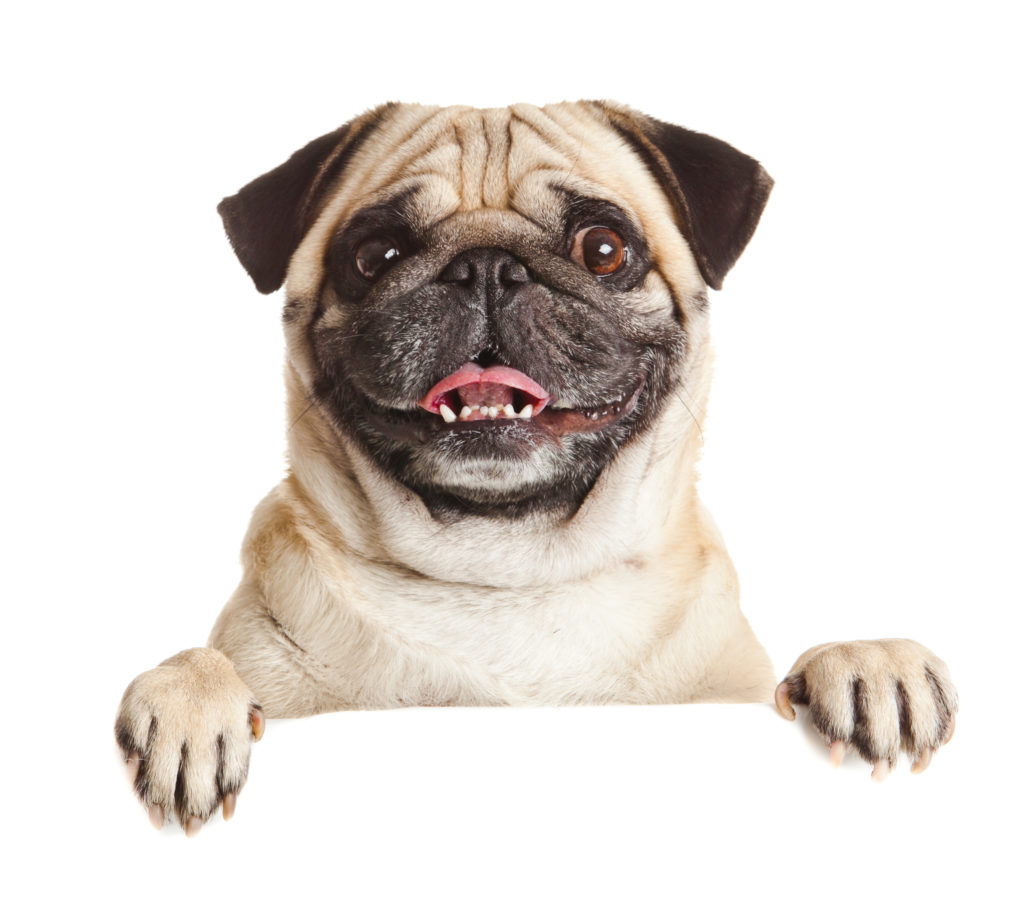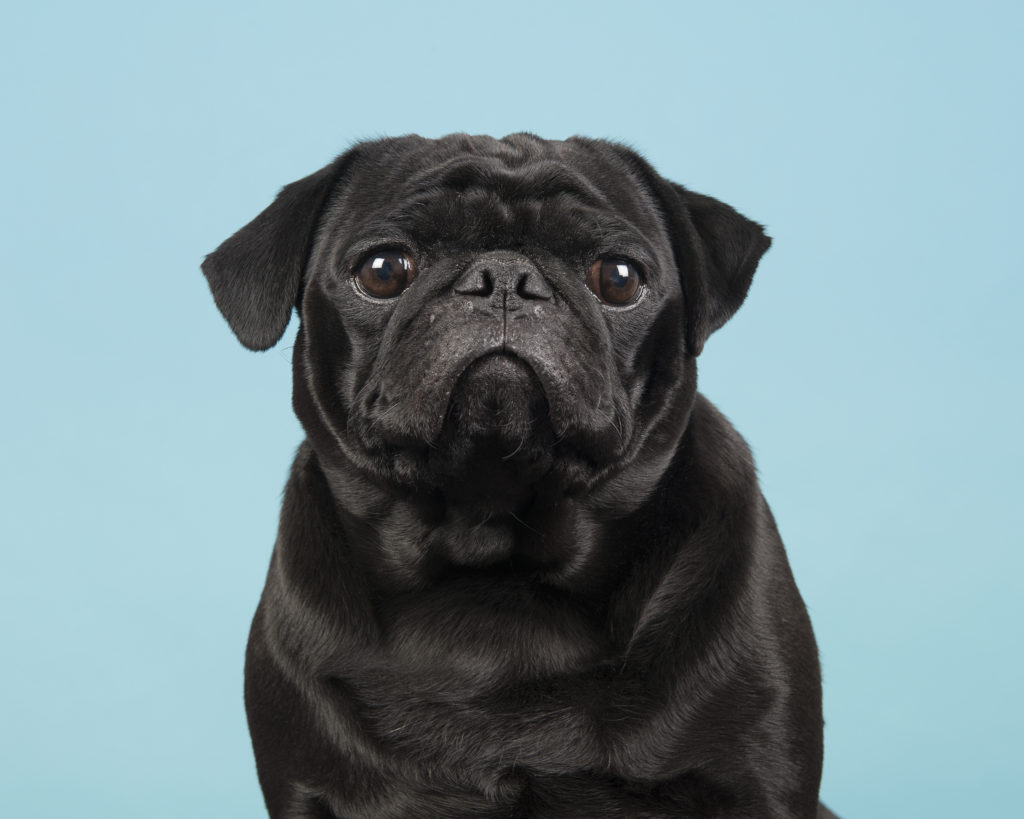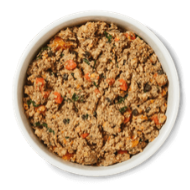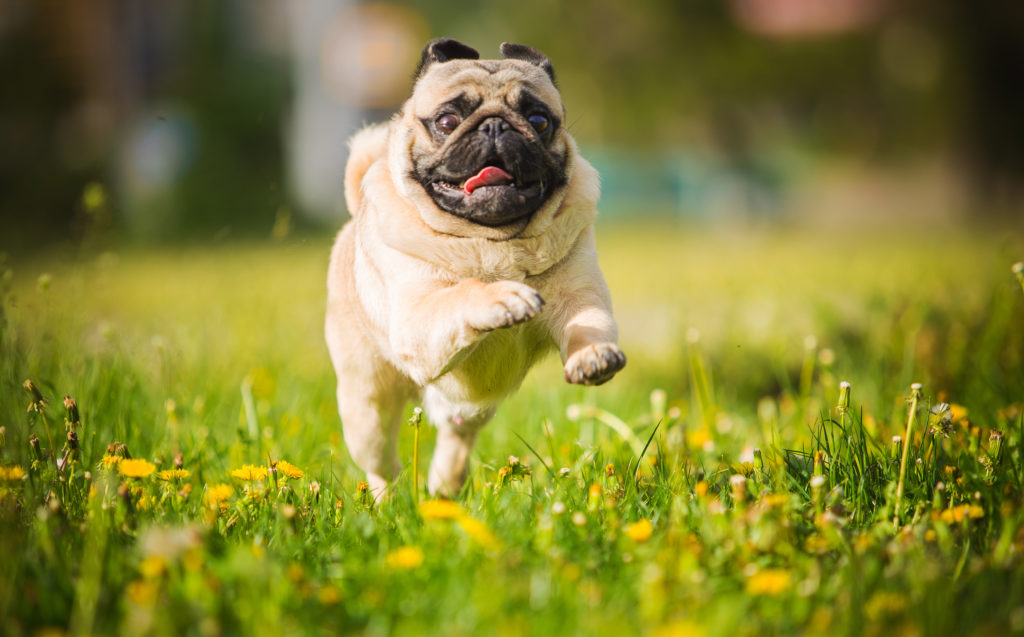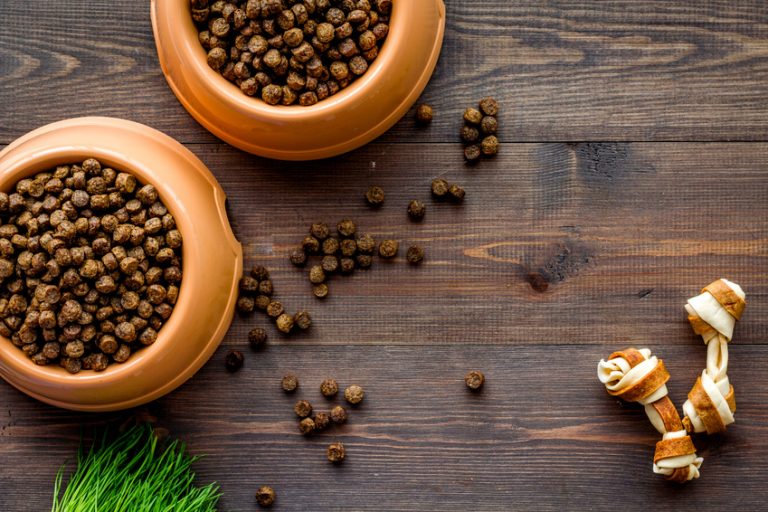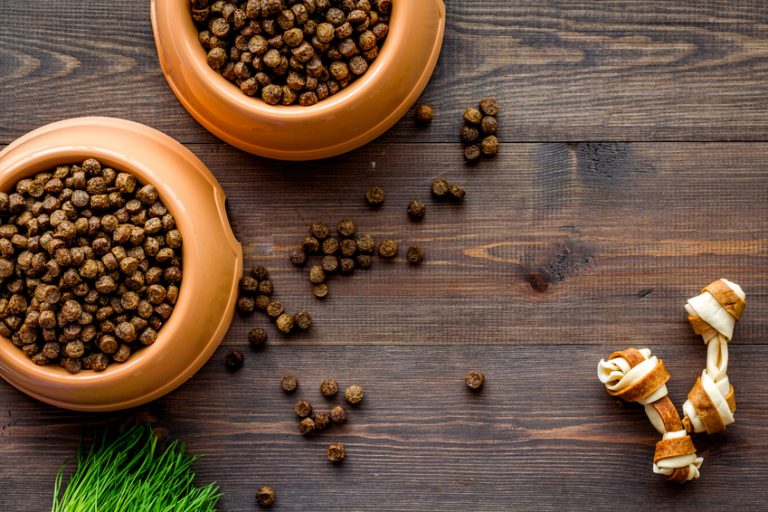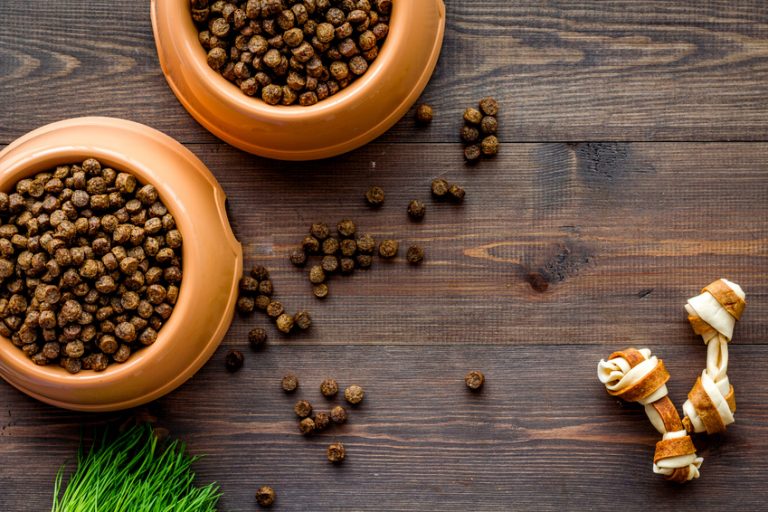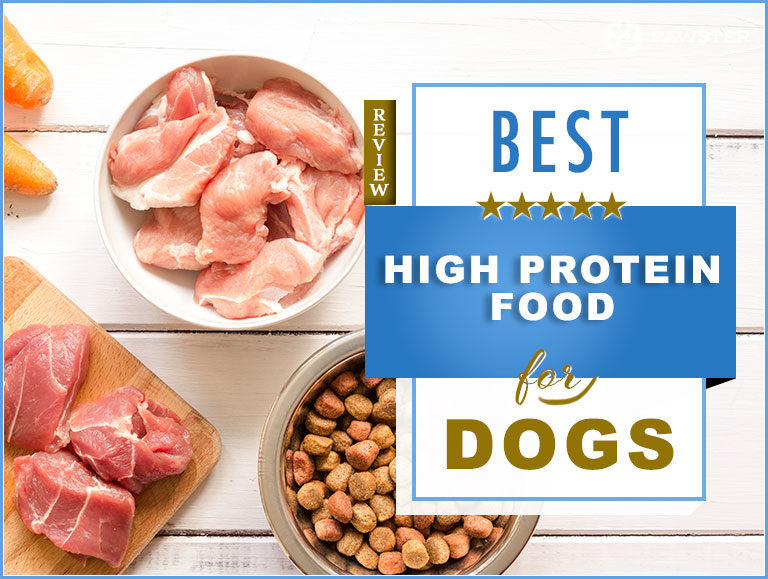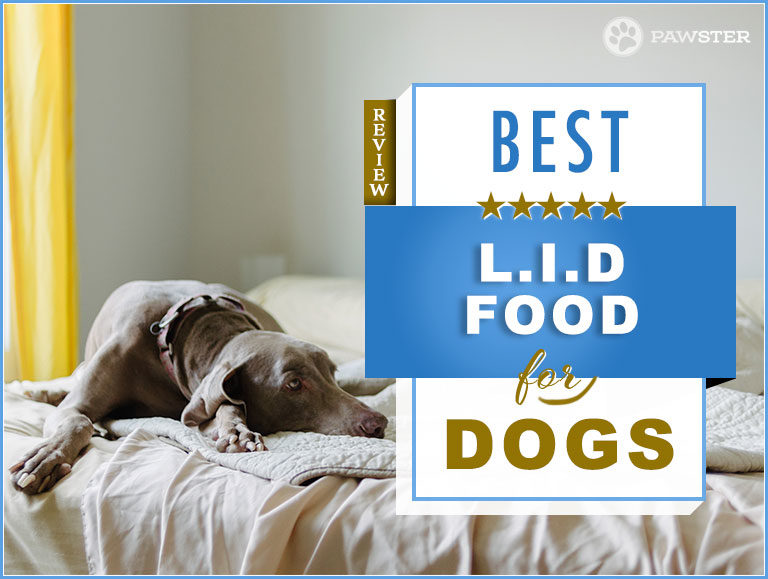7 Best Foods to Feed your Adult and Puppy Pug in 2024
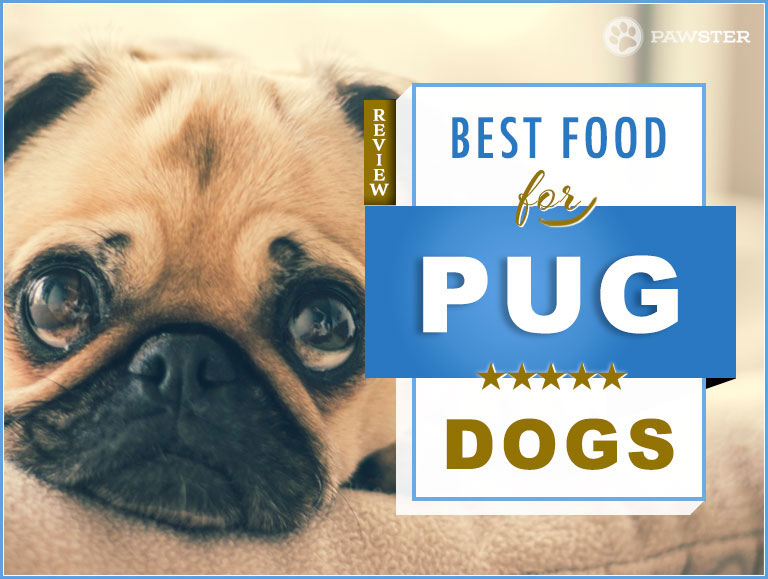
Contents of Article
Often described by the Latin phrase multum in parvo or, in modern terms, a lot of dog in a small package, it’s hard not to love the Pug. Their wrinkly face, short muzzle, and curled tail make the breed easy to identify. Pugs have lots of personality and they are known for being charming, friendly, sensitive, and eager to please. They can also be curious and mischievous at times. They are happy to be lazy at home with you. Taking naps is one of their favorite things to do. Pugs can be quiet at times but at other times they are playful and fun-loving. They like children and, even though they are a Toy breed, they are large and sturdy enough to play with kids and not get hurt. Pugs make a good companion for all kinds of people.
The Pug has a short, fine coat that does shed. Fawn is the most common color but the AKC also recognizes black Pugs. Pugs have a well-defined black mask on their faces which can be seen on fawn-colored dogs. Pugs weigh up to about 18 pounds. They are the largest member of the AKC’s Toy group. Historically, the Pug is a very old breed. It dates back to at least 400 BC in China, along with the Pekingese and the Shih Tzu.
What is the Best Dog Food for a Pug?
- Ollie Healthy Turkey Feast Fresh Dog Food
- Merrick Lil’ Plates Grain Free Real Chicken & Sweet Potato Recipe
- Wellness CORE Grain Free Small Breed Formula
- Whole Earth Farms Small-Breed Dry Food
- Wellness Complete Health Small Breed Puppy
- Canidae Grain Free PURE Foundations for Puppies with Chicken
- Earthborn Holistic Puppy Vantage
General Nutritional Recommendations
Dogs all have the same basic nutritional requirements, though some breeds and individual dogs can have some special dietary needs. Every dog needs the following nutrients in his diet:
- Water
- Protein
- Fat
- Carbohydrates
- Fiber
- Vitamins
- Minerals
Water
All animals need water to survive. The body’s functions depend on water. It carries nutrients to cells, helps the body digest and absorb food, and flushes toxins from the body. If your dog doesn’t have enough water, he will become dehydrated, sicken, and die in a short time. People give their dogs all kinds of water such as tap water, distilled water, well water, purified water, and so on. Basically, you should give your dog the same kind of water that you drink yourself. If water is not clean enough for you to drink, then it’s not clean enough for your dog. Dogs need about one ounce of water per pound of body weight per day, though this amount can vary. On hot days your dog may drink more. If you are feeding your dog a canned or “wet” dog food, which is mostly moisture, your dog may drink less water. Keep fresh, clean water available for your dog at all times.
Protein
Dogs also need good quality protein in their diets. Some people debate whether dogs are carnivores or omnivores (they have aspects of both) but they can digest animal protein more easily than plant protein.
Your dog gets his energy from the protein, fat, and carbohydrates he eats but protein also supports the immune system, repairs cells, builds lean muscle, and helps keep your dog’s skin and coat healthy. It’s good for dogs of all ages. Canine nutritionists generally believe that dogs benefit from higher amounts of protein, especially animal protein.
Ingredients
We recommend looking for dog foods that have whole meat or named meat meals as the first few ingredients. These meat ingredients can be followed by some plant proteins (peas, lentils), vegetable starches (sweet potatoes, for example), OR some less common grains (oats, barley). But it’s important for the first two or three ingredients in the food to be good meat ingredients. As many dog owners know, dog food ingredients must be listed by their weight before cooking, so having good meat ingredients listed first should ensure that the food has some good meat protein for your dog. Be aware that whole meat proteins (whole chicken, for example) are mostly water, so it’s not enough to have food with these meat proteins listed first. This kind of ingredient would be placed lower in the list after cooking. A good named meat meal (chicken meal or turkey meal, for example), which has already had most of its moisture removed, is mostly protein, so it’s a good ingredient to see listed near the top of the ingredient list.
A Balanced Diet
AAFCO (the Association of American Feed Control Officials) recommends that adult dogs such as Pugs have at least 18 percent protein in their diet. Growing puppies need at least 22 percent protein in their diet. Most dog foods today will have protein percentages higher than these recommendations. There are some exceptions, such as limited ingredient diets (LID) or hypoallergenic foods which can have rather low protein percentages so be sure to check the protein percentage with these foods.
Most experts suggest that healthy adult dogs eat a diet that has higher protein, moderate fat, and low carbs. If your Pug has a health problem of any kind, we recommend that you consult your veterinarian. Your veterinarian may recommend a prescription diet for certain health problems.
Meat, poultry, fish, and eggs are all good sources of animal protein for dogs. They can provide the essential amino acids he needs he needs in his diet. Plant sources of protein can provide some of these amino acids but in most cases they can’t provide all of them. They are usually lacking one or more of the essential amino acids that dogs need.
Fat is also an important part of your dog’s diet. It provides omega-3 and omega-6 fatty acids for healthy skin and coat, brain development, heart function, and your dog’s eyes. Essential fatty acids (EFA) help your dog absorb vitamins A, D, E, and K.
According to AAFCO, adult dogs need a minimum of 5 percent fat in their diets. Puppies need a minimum of 8 percent fat. Most dog foods today have higher fat percentages than these recommendations. You can find weight control dog foods that have these minimums but most other dog foods tend to have higher percentages. The fat in a dog food has a lot to do with the taste or “palatability” of the food, from your dog’s viewpoint. Your dog may care less about whether a food is chicken, lamb, or beef, as long as it has plenty of fat. Given a choice, your dog will often choose a food that has more fat. This is one reason why canned dog foods are so appealing to dogs. Many of them have a high fat content compared to dry dog food. While dogs like more fat, too much fat is not good for your dog. It can lead to obesity which, in turn, can lead to health problems and shorten your dog’s life. It’s always important to watch fat percentages and calories in dog foods.
As with protein, fat from animal sources is easier for your dog to use. Good sources of fat for your dog include named sources such as chicken fat and fish oil, such as salmon oil. This is important to know since many dog food companies include flaxseed oil in their formulas, saying that it’s a source of omega-3 fatty acid. This is only partly true. It is a source of omega-3 fatty acid, but dogs are not able to use it very well. Plant sources of omega-3, like flaxseed oil, contain alpha linolenic acid (ALA), which is an inactive precursor to the omega-3 fatty acids EPA and DHA. Dogs don’t have the enzymes need to break ALA down to a usable form. Dogs need omega-3 from animal sources, such as fish oil if they are going to use it.
Dog foods that have fat percentages between about 12 and 16 percent (dry matter basis) are usually considered to be moderate in fat by today’s standards. Foods that have protein percentages between about 24 and 32 percent (dry matter basis) are usually suitable for most healthy adult dogs. There are many good quality dog foods that have these percentages.
Carbohydrates
Dogs also need carbohydrates in their diet. Carbohydrates are more than just “filler” ingredients or grains. Many of the vegetables used in grain free dog foods are mostly carbohydrates. For example, sweet potatoes are more than 90 percent carbs. Chickpeas are almost 70 percent carbs. Carbohydrates also provide sources of fiber in dog foods. Prebiotics such as chicory and beet pulp come from carbohydrates. Carbs are a source of energy for dogs. Carbs are only a problem in dog foods when they come from poor quality ingredients or when there are too many of them in a food.
Many dog foods today have between 30 and 50 percent carbohydrates. It is concerning when foods have huge amounts of carbs. While dogs can digest carbs/starches, when foods have lots of carbs it means they have less meat protein. Some carb sources are also not very high in nutritional quality. We agree that it’s a good idea to try look for dog foods with lower carbs. However, it’s not always easy to find such foods. A few foods have very low carb percentages (15-20 percent) but you will probably find that even some of the best dog foods have more carbohydrates than you expect.
You are most likely to find very low carbohydrates in some canned dog foods. Unlike dry dog food which needs some starch/carbohydrates to form a dough or batter and go through the dog food machinery, canned dog food doesn’t necessarily have to have carbohydates in the recipe. (Although some canned dog foods do use gums and thickeners or starches to give the food shape, or to form a gravy.)
Dog food companies are not required to provide carbohydrate information for their foods but some companies do provide this information on their web sites. Check the FAQ section. Or you can read dog food reviews on Pawster to find information about carbohydrates; or try to figure carbs for yourself.
Vitamins and Minerals
Like all dogs, Pugs need vitamins and minerals in their diet. Many people assume that the vitamins and minerals in dog foods come from the food ingredients. This is only partly true. Most dog foods are cooked at such high temperatures that some of the nutrients are lost during the manufacturing process. To compensate, dog food companies typically add extra vitamins and mineral to their foods. That’s why you usually see a long list of vitamins and minerals on a pet food label. Many companies buy pre-packaged vitamins and minerals from other countries such as France, Japan, Canada, and China. Some pet owners are alarmed by the sources of these ingredients though, it should be said that companies don’t always have many options about where they can obtain certain minerals. If you are concerned about vitamins and minerals sourced from China, check the company’s FAQ page. Some companies try to address this issue. Or you can contact the company directly to let them know about your concerns.
Artificial Flavors, Colors, and Sweeteners
Dog owners should avoid foods that have artificial flavors, colors, and sweeteners. We consider “natural flavor” to be questionable because of the vagueness of the term. “Caramel” is a coloring and/or sweetener. Artificial preservatives include: ethoxyquin, butylated hydroxyanisole (BHA), butylated hydroxytoluene (BHT), tertbutyl hydroquinone (TBHQ), and propyl gallate. Vitamin E, Vitamin C, and certain plant extracts such as rosemary oil are often used as natural preservatives. Natural preservatives will not keep a food fresh as long as artificial preservatives but they are considered to be healthier for your dog.
What is the Best Dog Food for My Pug?
Most good quality dog foods today are formulated to be suitable for all dogs. You can look for foods that are AAFCO-approved for “All life stages.” These foods would be a good place to start when looking for foods for your Pug. You can feed them to puppies, adults, and senior dogs. Or you can choose a food that is specially-formulated for small breeds.
If your Pug has any special conditions, such as a food allergy, it’s a good idea to talk to your veterinarian. She may suggest an elimination diet and food trial. If you know the foods that trigger a reaction for your Pug, you may be able to simply avoid foods that have those ingredients. If your Pug has a severe allergy or sensitivity; if you can’t figure out the trigger or avoid it; or if your dog is allergic to multiple ingredients, you may need to feed a prescription diet. Talk to your vet.
Here are some good foods that we like for adult Pugs:
Ollie Healthy Turkey Feast Fresh Dog Food
Healthy Ingredients : Turkey breast, turkey liver, kale, carrots, lentils
Key Features :
- Human-Grade
- Based on your dog specifically
- Fresh food
- Subscription service
Ollie Healthy Turkey Feast Fresh Dog Food
Ollie Healthy Turkey Feast Fresh Dog Food is a fresh, human-grade dog food that is based on a profile you complete about your dog. It is delivered right to your doorstep.
Ollie is a great fresh food option for your pug. Considered a super-premium dog food, Ollie uses human-grade ingredients and slow cooks their recipes to preserve the nutritional integrity of your pet’s meal. They don’t use any artificial flavors or fillers in any of their recipes, so you can be sure that your dog is getting whole, fresh ingredients and nothing more. When you sign up for Ollie, you will fill out a profile about your dog to help them create a customized recipe and delivery schedule that will suit your needs. The food is delivered to your doorstep and stored in your fridge or freezer, ready to serve when your pet needs it. Although Ollie is more expensive than other dog foods, there are a lot of added benefits that make a fresh food diet something to consider!
Merrick Lil’ Plates Grain Free Real Chicken & Sweet Potato Recipe
Healthy Ingredients : Deboned Chicken, Chicken Meal, Turkey Meal, Sweet Potatoes, Potatoes
Key Features :
- Just for small breeds
- 70% poultry or fish
- No grain
- Kibble and canned formulas available
Merrick Lil’ Plates Grain Free Dog Food
Merrick Lil’ Plates Grain Free Real Chicken & Sweet Potato Recipe is for all life stages and is totally grain free. 70% of the ingredients come from poultry or fish and it is created just for small breeds.
Merrick’s Lil’ Plates Grain Free Recipes is a bestseller for many people with small dogs like Pugs. The first five ingredients are: deboned chicken, chicken meal, turkey meal, sweet potatoes, and potatoes. It’s an all life stage food with 430 kcal/cup, and it has 38 percent crude protein; 17 percent crude fat. It’s grain free with no corn, wheat, or soy, and it has no gluten. According to Merrick, 70 percent of the ingredients come from poultry or fish. And it’s specially-formulated for small breeds. We think it’s a good choice for Pugs. Merrick’s Lil’ Plates comes in both kibble and canned formulas, and many recipes if your dog prefers a different flavor.
Wellness CORE Grain Free Small Breed Formula
Healthy Ingredients : Deboned Turkey, Turkey Meal, Chicken Meal, Potatoes, Peas
Key Features :
- Supports healthy joints
- Protein rich
- Grain free
- Supports healthy skin and coat
Wellness CORE Grain Free Small Breed Formula
Wellness CORE Grain Free Small Breed Formula is made just for small breeds and is protein rich and grain free. It has omega fatty acids and glucosamine and chondroitin for joint support.
Wellness CORE Grain Free Small Breed Formula is another popular food for Toy/small breeds. It has 36 percent crude protein and 15 percent crude fat, with 396 percent kcal/cup. The first five ingredients are: deboned turkey, turkey meal, chicken meal, potatoes, and peas. This formula is gluten-free with no corn, wheat, soy, artificial flavors, colors, or preservatives. It also has a smaller kibble size to make it easier for small dogs to eat. In addition, it has omega fatty acids from salmon oil for a healthy skin and coat; glucosamine and chondroitin for better joint health; and antioxidants.
Whole Earth Farms Small Breed Grain-Free Dry Dog Food
Healthy Ingredients : Chicken Meal, Potatoes, Peas, Chicken Fat, Sweet Potatoes
Key Features :
- Reduces shedding
- Promotes a healthy coat and strong nails
- Grain free
- Supports healthy digestion
Whole Earth Farms Small Breed Grain-Free Dry Dog Food
Whole Earth Farms Small Breed Grain-Free Dry Dog Food is packed with nutrition that helps to support digestion, reduce shedding, and promote a healthy coat and strong nails. It is grain free and made for small breeds.
Your pug will get the nourishment he needs at mealtime with Whole Earth Farms Grain Free Dry Dog Food Small Breed Recipe with Chicken and Turkey. This natural dry food for small dogs like your pug has a flavorful blend of high-quality chicken and turkey. It also includes apples, sweet potatoes and flaxseed for complete and balanced nutrition, especially great for sensitive stomachs. It is grain-free dry and includes added vitamins, minerals and probiotics to support healthy digestion, help reduce shedding, promote a shiny coat and encourage strong nails and skin. Whole Earth is made without any grains, corn, wheat, soy, by-products, artificial colors, flavors or preservatives and made in the USA.
What is the Best Food for Pug Puppies?
As with other small breeds, Pug puppies often need several small meals throughout the day. By the time they are about six months old you should be able to start cutting back to two or three meals per day. Remember to watch your puppy’s weight. Being overweight, even as a puppy, puts extra stress on growing bones and joints. This can lead to hip dysplasia and arthritis later in life. Keep your Pug puppy slim.
Wellness Complete Health Small Breed Puppy
Healthy Ingredients : Deboned Turkey, Chicken Meal, Oatmeal, Salmon Meal, Ground Barley
Key Features :
- Higher in calories
- Protein rich
- DHA for brain and eye health
- Easily digestible
Wellness Complete Health Small Breed Puppy
Wellness Complete Health Small Breed Puppy has high quality protein and DHA, among other nutritional benefits for your puppy. It is protein rich and has higher calories than normal dog foods.
Wellness makes several foods for puppies in their CORE line of foods and in their Wellness Complete line. We have selected Wellness Complete Health Small Breed Puppy formula for Pugs, but your puppy might prefer one of the other formulas. The first five ingredients in this food are: deboned turkey, chicken meal, oatmeal, salmon meal, and barley. This food and some of these ingredients, such as oatmeal and barley, are considered to be easy for puppies to digest. It has high quality protein; and salmon oil is a natural source of DHA, an omega-3 fatty acid. It has 28 percent crude protein and 19 percent crude fat. And it has 489 kcal/cup. Remember that many foods for small breeds, including puppy foods, have more calories than ordinary dog foods. You don’t have to feed Pug puppies a lot of food at one time, especially since you will be feeding them several small meals per day in the first few months.
Canidae Grain Free PURE Foundations for Puppies with Chicken
Healthy Ingredients : Chicken, Menhaden Fish Meal, Lentils, Peas, Potatoes
Key Features :
- Protein rich
- Good for food sensitivities
- Digestible carbs
- Antioxidants for immune health
Canidae Grain Free PURE Foundations for Puppies with Chicken
Canidae Grain Free PURE Foundations for Puppies with Chicken has antioxidants for immune health and highly digestible carbs for energry. It is protein rich and made just for puppies.
Canidae makes several good puppy foods but we like this grain free food for Pug puppies. This food is a limited ingredient formula that has 30 percent crude protein and 12 percent crude fat, with 520 kcal per cup. That’s a lot of calories and nutrients packed into each ounce so your Pug won’t have to eat very much at each meal to get the nutrition he needs. The first five ingredients in this food are: chicken, menhaden fish meal, lentils, peas, and potatoes. This food has antioxidants to keep the immune system strong; and probiotics for good digestion. We think the Pugs and other puppies will do well with this food.
Earthborn Holistic Puppy Vantage
Healthy Ingredients : Chicken Meal, Whitefish Meal, Oatmeal, Ground Barley, Ground Brown Rice
Key Features :
- Well-balanced
- Affordable price
- DHA for brain and eye health
- Omega fatty acids for skin and coat
Earthborn Holistic Puppy Vantage
Earthborn Holistic Puppy Vantage is a great puppy food at an affordable price. It has DHA for brain and eye health and Omega fatty acids for skin and coat health. It is easy to digest and well-balanced.
Earthborn is popular for their adult dog formulas. They make good foods at a reasonable price. We think this puppy food, made for all breeds, is also a good selection. Earthborn Holistic Puppy Vantage has 28 percent crude protein and 20 percent crude fat, with only 32 percent carbohydrates – quite low compared to many dog foods. It has 445 kcal/cup. The first five ingredients are: chicken meal, whitefish meal, oatmeal, ground barley, and ground brown rice. The food also has DHA for good brain and eye development; and a good ratio of omega-6 and omega-3 fatty acids for healthy skin and coat. The carbs in the food come from sweet potatoes, oatmeal, barley, and brown rice which are all easy for puppies to digest. It also has the proper balance of calcium and phosphorus for good bone development. We think this food would be a good food for Pug puppies.
Special Dietary and Nutritional Considerations
Toy and small breed dogs such as Pugs (dogs under 20 pounds) usually need about 40 calories per pound/per day. These small breeds generally have a faster metabolism than larger dogs. However, this is only a generalization. It’s important to consider other factors when determining how much to feed your Pug, such as your dog’s activity level, his age, his weight and condition, whether he’s neutered or intact, his general health, and so on. Pay attention to whether your Pug is gaining or losing weight and adjust his meals as necessary. You can see some of the charts and tables used to make calorie calculations here.
If your adult Pug weighs 18 pounds, he may need approximately 610 calories per day. If your Pug is neutered or very inactive, he may need a few less calories – perhaps around 542 calories per day. Again, these calorie suggestions are only starting points. You can adjust them according to your dog’s individual needs. If you have a super Pug who is walking a mile a day with you, he might need more calories.
Pugs can eat many good quality dog foods. You could choose an all life stage food designed for dogs of all breeds/all ages. Or you could feed your adult Pug a good quality food for adult maintenance. (These foods are not suitable for puppies.) Some Pug owners prefer to feed their dog a food that is specially formulated for small breeds. These foods usually have more calories per ounce than other dog foods because Toy/small breeds often have faster metabolisms. They can have more nutrients per ounce, too. The stomach of a small dog is not very big so they don’t eat very much at each meal compared to big dogs. For this reason it’s important to pack each ounce of food with the nutrients they need. The kibble pieces in small breed foods are often smaller, too, so they are easier for Toy/small breeds to eat.
There are similar choices when it comes to puppy foods. You can choose a regular puppy food for all breeds, an all life stage dog food that is also suitable for puppies (sometimes labeled or “growth and reproduction”), or you can choose a puppy food formulated for Toy/small breed puppies.
Since Pugs can have some problems with hip dysplasia and arthritis as adults, you may want to look for an adult dog food that includes joint supplements such as glucosamine and chondroitin. There is some debate about whether these supplements actually help, but many dog owners feel that they do.
Some Pugs can also be prone to some skin allergies and food sensitivities. You may need to work with your veterinarian to identify your dog’s food triggers. You may also need to feed a good grain free dog food or a limited ingredient diet (LID) to avoid some of the most common proteins.
If you have questions about your Pug’s weight and condition, check with your puppy’s breeder or your veterinarian.
| Pug Dog Food Comparison Table | |||
| Rank | Product | Price | Rating |
| Human Grade |
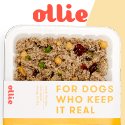 |
Varies |
A+
|
| #1 |
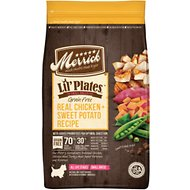 Merrick Lil’ Plates Grain Free Real Chicken & Sweet Potato Recipe |
$3.07/lb |
A+
|
| #2 |
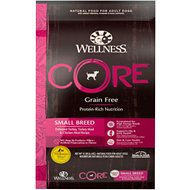 |
$3.00/lb |
A+
|
| #3 |
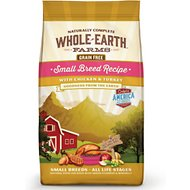 |
$2.45/lb |
A
|
| #4 |
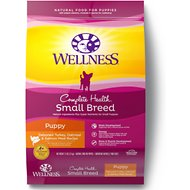 |
$2.77/lb |
A+
|
| #5 |
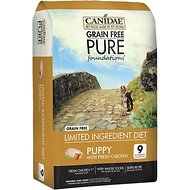 Canidae Grain Free PURE Foundations for Puppies with Chicken |
$2.37/lb |
A+
|
| #6 |
 |
$1.23/lb |
A-
|
Frequently Asked Questions about Feeding a Pug
Does the source of the protein I feed my pug matter?
The source of the protein does matter. This is something you should keep in mind when you are looking at dog food labels. Many dog foods today can have a high protein percentage but you should look at the ingredients to see how much of the protein comes from animal sources and how much comes from plant sources. Lots of foods today, even well-known, expensive dog foods, use plant proteins such as peas and lentils. These ingredients do have some health benefits but they also boost the protein percentage. So, when you see a dog food with 30 percent protein (as fed) but it has peas and lentils among the first few ingredients, you should suspect that a lot of the protein in the food is plant-based.
How much fat and protein should my pug be getting?
A healthy adult dog that’s not getting any vigorous exercise needs a fat percentage that is about half of the food’s protein percentage. If you are feeding your Pug a kibble that has a protein percentage of 26 percent, a fat percentage of about 13 percent would be suitable. Toy/small breed dogs do burn more calories per pound than larger dogs so you may want to consider feeding a food that is formulated for small breeds. These foods usually have more calories per ounce than other dog foods. They may have kibble that is smaller in size so it’s easier for small breeds to eat it. Toy/small dogs may not be able to eat a lot at one meal so the food has more calories and nutrients in each ounce.
Should I choose a grain-free food for my dog?
Whether you feed a grain free food or not is up to you. Corn and wheat have been thoroughly slammed by many dog food commentators, though you can still find smaller amounts of corn in some high performance dog foods. It’s not true that all grains should be avoided; or that dogs can’t digest grains; or that dogs are allergic to all grains. If your dog has problems eating foods with grain, by all means look for one of the good grain free dog foods. On the other hand, if your dog doesn’t have difficulty eating grains, you have more options. There are some excellent foods now that are, rather shyly, introducing “ancestral grains” as ingredients. These grains include spelt (an ancient form of wheat), oats, barley, quinoa, and the like. If your dog has had problems eating corn or conventional wheat, you might try one of these foods. Just keep in mind that all carbs are not bad. It’s only when they are used to excess or when they come from poor quality sources that you need to avoid them.
Conclusion
There are lots of good dog and puppy foods today, including foods for toy breeds like Pugs. The foods here are only a few suggestions. The most important thing is to find a food that works for your dog. We hope you will take the information offered here and use it to choose a good food for your dog. If you need any help, start with one of the foods recommended or check out some of the foods reviewed in our pages here on Pawster.

